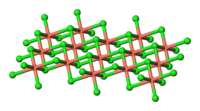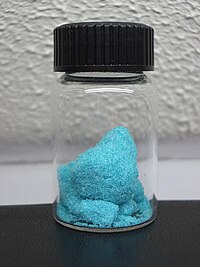Copper(II) chloride
Copper(II) chloride, also known as cupric chloride, is a chemical compound. Its chemical formula is CuCl2. It contains copper in its +2 oxidation state. It also contains two chloride ions.
| Copper(II) chloride | |
|---|---|

| |

| |

| |
| Other names | Cupric chloride |
| Identifiers | |
| CAS number | |
| PubChem | |
| ChEBI | CHEBI:49553 |
| RTECS number | GL7000000 |
| SMILES | Cl[Cu]Cl |
| Properties | |
| Molecular formula | CuCl2 |
| Molar mass | 134.45 g/mol (anhydrous) 170.48 g/mol (dihydrate) |
| Appearance | yellow-brown solid (anhydrous) blue-green solid (dihydrate) |
| Odor | odorless |
| Density | 3.386 g/cm3 (anhydrous) 2.51 g/cm3 (dihydrate) |
| Melting point |
498 °C, 771 K, 928 °F |
| Boiling point | |
| Solubility in water | 70.6 g/100 mL (0 °C) 75.7 g/100 mL (25 °C) 107.9 g/100 mL (100 °C) |
| Solubility | methanol: 68 g/100 mL (15 °C)
|
| +1080·10−6 cm3/mol | |
| Structure | |
| Crystal structure | distorted CdI2 structure |
| Coordination geometry |
Octahedral |
| Hazards | |
| EU classification | Not listed |
| NFPA 704 |
|
| Flash point | Non-flammable |
| U.S. Permissible exposure limit (PEL) |
TWA 1 mg/m3 (as Cu)[1] |
| Related compounds | |
| Other anions | Copper(II) fluoride Copper(II) bromide |
| Other cations | Copper(I) chloride Silver chloride Gold(III) chloride |
| Except where noted otherwise, data are given for materials in their standard state (at 25 °C, 100 kPa) | |
Properties
Copper(II) chloride is light brown when anhydrous. It is green when hydrated. It is a weak oxidizing agent. It reacts with aluminium foil to make hydrogen, copper(I) oxide, and aluminium chloride. This is used in school demonstrations. It releases chlorine and turns into copper(I) chloride when heated very hot. It reacts with sodium hydroxide to make copper(II) hydroxide. Copper(II) chloride reacts with metals to make metal chlorides and copper. It puts out blue flames if it is heated in a flame. It reacts with sulfur dioxide to make copper(I) chloride. It dissolves in water to make a blue solution. When more chloride is added, it turns green, then yellow.[2]
Preparation
It is made by reacting copper with chlorine. It can also be made by reacting copper(II) hydroxide, copper(II) oxide, or copper(II) carbonate with hydrochloric acid and from pure copper and from 1:1 solution of hydrogen peroxide and hydrochloric acid where copper first get oxidized to CuO from H2O2 and then reacts with HCl to form CuCl2, reaction goes like this:
Cu + H2O2 → CuO + H2O
CuO + 2HCl → CuCl2 + H2O
Uses
Copper(II) chloride is used to make fungicides. It is also used to make organic compounds. It is also used to make acetaldehyde from ethane. [4]
Safety
It is toxic, with toxicity similar to copper sulfate It is therefore harmful. [5]
Related pages
References
- ↑ NIOSH Pocket Guide to Chemical Hazards. "#0150". National Institute for Occupational Safety and Health (NIOSH).
- ↑ "Amazing Rust.com - CuCl2". www.amazingrust.com. Archived from the original on 2019-06-26. Retrieved 2019-02-14.
- ↑ "Types of Reactions". www.wiredchemist.com.
- ↑ "USES and APPLICATIONS of CHEMICALS elements compounds mixtures formulations". www.docbrown.info.
- ↑
Copper(II) Chloride Media
"Copper FAQ - Dartmouth Toxic Metals Superfund Research Program". www.dartmouth.edu.
